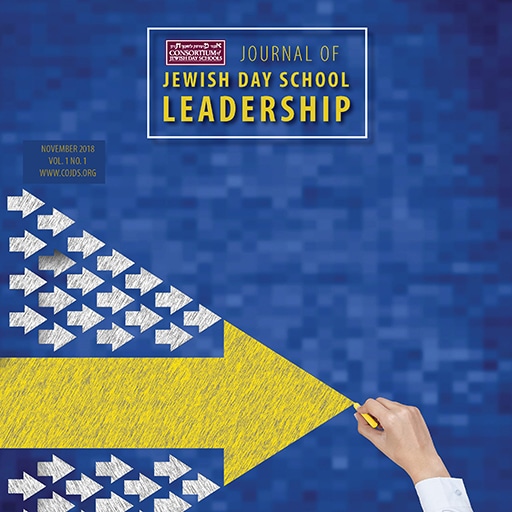
Seeking Submissions
January 3, 2022
CoJDS’ Curriculum Development–A Closer Look
January 17, 2022by Adina Broder
Ask most Parshat Hashavua teachers to describe the curriculum for their class, and you will likely be met with a puzzled look. It’s as if you asked who is buried in Grant’s tomb or what is the color of the White House. The class is called Parshat Hashavua, which seemingly says the curriculum right in the name. This reaction is understandable only if one defines the term curriculum to refer simply to the subject matter or topic being taught. If, however, one views curriculum beyond its colloquial usage to include the specific content and skills that teachers are intended to impart to their students, the question regarding a Parshat Hashavua curriculum makes perfect sense.
The latter view of curriculum helps give teachers a framework for teaching their students. It conveys to teachers what content they should emphasize and which skills need to be developed. This understanding of curriculum is often applied in secular studies, either explicitly or implicitly, through the use of district-wide textbooks or the adherence to state standards.[1] If this meaning of curriculum were to be applied to Judaic Studies subjects, a Chumash curriculum, for instance, would consist of more than which parshiot teachers should cover. It would also include what specifically students need to know (e.g., which perushim and midrashim) and what students need to be able to do (e.g., identify shorashim, analyze Rashi’s commentary, etc.). Having such a detailed curriculum has practical implications for teachers’ pedagogical choices in the classroom. It would inform their selection of material, the instructional methods they employ, and the assessments they prepare. All of these — content, instructional methods, and assessments — should be guided by and aligned with the specified curriculum.[2]
There are further benefits to using a clearly specified curriculum. It ensures that students in the same grade are learning the same material. This is known as horizontal coherence or horizontal mapping. Furthermore, it allows teachers in subsequent grades to rely on students having mastered certain skills, which can be used as a foundation for learning. This is referred to as vertical coherence or vertical mapping. As a result of having a detailed curriculum, there is alignment within and across grades, which prevents gaps and redundancies in students’ education.[3]
In spite of all the benefits, too few Jewish day schools provide their teachers with the type of comprehensive and cohesive curriculum described above.[4] This is true in all Judaic Studies, but especially for Parshat Hashavua and Dinim of the Yamim Tovim. Every year from elementary school through middle school (and often beyond), students are taught these subjects. But rather than directing teachers as to which information should be emphasized and which skills should be taught at each grade level, schools often leave teachers to make these determinations on their own, in isolation of one another.[5]
In Parshat Hashavua class, this results in some teachers providing a summary of the parsha, others choosing to focus on one particular topic within the parsha, and still others simply sharing a weekly dvar Torah with their students. Because of these diverse approaches, students are often left with a piecemeal familiarity of the Torah, rather than a solid bkeius knowledge. Moreover, some students hear the same summary of the parsha year after year, without additional information or explanation. This often leads to student disengagement.
Furthermore, very few Parshat Hashavua teachers focus on anything other than content, which is a lost opportunity to develop students’ skills. Throughout their yeshiva day school tenure, students generally aren’t taught how to summarize a parsha or find its roshei perakim. Even more unfortunate, most students aren’t given the tools to compose an original dvar Torah. As such, when called upon to share a dvar Torah at a Shabbat meal or simcha, they resort to searching for one online. As educators, we are neglecting an important skill if we fail to teach students how to develop an original idea on the weekly parsha.
The teaching of Dinei Yamim Tovim fares no better. With regard to the content, some teachers spend weeks teaching the halachot in depth, while others provide a cursory review a day or two before the impending Yom Tov. Some use a text; others do not. As far as skill development is concerned, few teachers educate their students on how to use a Mishna Brurah or similar texts, let alone acquaint them with their distinctive terminology.
To combat these deficiencies, I propose that teachers be provided with a spiral curriculum in these recurring subjects. Spiral curricula are specifically geared to those topics which students revisit multiple times throughout their schooling. According to Jerome Brunner, to whom the concept of spiral curriculum is attributed, each time these subjects are presented, they are to be taught on a deeper level, with increased content and a strengthening of skills.[6] Examples of spiral curricula in the secular realm include Biology and U.S. History. These topics are often introduced in elementary school, developed in middle school and elaborated upon in high school. In Biology, for example, students’ first encounter with the concept of cells might simply involve teaching what cells are and what they do. Later on, students may learn more deeply about the structure and function of cells. Further study in high school might involve teaching how biological processes work at the cellular level. This type of progression is warranted in light of students’ growing cognitive abilities.
The same logic holds true for the Judaic subjects of Parshat Hashavua and Dinim of Yamim Tovim. The material presented should increase in complexity as students mature in order to increase the breadth and depth of students’ understanding. For Parshat Hashavua, the content and skills ought to reflect the students’ growing capacity to contemplate conceptual, theological and ethical ideas. For Dinei Yamim Tovim, as students advance they should be gaining a deeper understanding of the halachot, including their sources in Tanach, Mishna and Talmud, as well as their application in various, complex situations.
To see how such a curriculum might look in practical terms, the following are suggestions of how to spiral the Parshat Hashavua curriculum:
In the elementary grades, teachers provide their students with a summary of each of the weekly parshiot, with it becoming more detailed and comprehensive as the years progress. Thus, while Chumash class focuses on developing students’ textual and analytical skills, Parshat Hashavua offers a broader context for their in-depth learning. This provides students with a framework into which they can fit the particular parsha they are learning in Chumash class. In this way, the macro scope of Parshat Hashavua class is a nice complement to the micro focus of Chumash class.
Once students move into upper elementary school, rather than being given a summary of the weekly parsha, students are expected to prepare the summary themselves. To do this, students don’t simply paraphrase the content from parsha websites, but instead read through the pesukim (with their English translation) and select the most important information. This might be done by dividing each parsha into its aliyot, where groups of students prepare the summary on their assigned aliyah. These summaries are joined together, so that each week the students as a whole have prepared the source material for the course.
As students progress through middle school, well-known and often-quoted Rashis are included in the summary of the parsha. This transitions into students being given the list of the Rashis, instead of their content. Students are tasked to learn those Rashis on their own or with a chavruta, to be reviewed as a class. The skills that students gain from such an activity will serve them well in their Chumash classes, and prepare and encourage them to become independent learners.
When students move into high school, their thorough parsha knowledge enables them to engage in comparative, intertextual analysis in order to appreciate the relationships that exist between different passages of the Torah. In addition, students identify and learn the roshei perakim of each parsha so that they know the main events that occur. Students also learn the inverse, i.e., knowing in which parsha certain events or topics are found. As a result, students are able to cite which parsha discusses the laws of kosher animals, parah adumah, etc. With regard to skills, students are taught how to write original divrei Torah. Through scaffolding, students learn how to identify an issue in the parsha, synthesize sources that discuss that issue, and develop an original idea along with a take-away message.
Such a spiral curriculum is aligned with and supported by Bloom’s hierarchical ordering of cognitive skills.[7] Learning begins, according to Bloom, with basic, foundational knowledge, in this case with understanding and retaining the contents of the weekly parsha during the lower grades. Learning can then progress to more complex types of thinking, where students are challenged to analyze and evaluate that material. This culminates in students being able to use their learning to create something new, as an original d’var Torah in this example.
Like the spiral curriculum outlined above for Parshat Hashavua, teaching Dinim of the Yamim Tovim can follow a similar systematic progression. Having such spiral curricula would ensure that there wouldn’t simply be a repetition of material in subjects that students encounter every year. Instead, schools would take advantage of the fact that these are recurring subjects by reinforcing and intensifying the material each time the students revisit the subject matter. This should lead to improved learning outcomes and student performance. [8]
By reimagining how Parshat Hashavua and Dinim of the Yamim Tovim are taught, schools can elevate these subjects to higher academic levels. More importantly, it will instill a greater appreciation and love for these Torah subjects in our children. These are benefits that will accrue throughout their lives, as the cycle of parshiot and Yamim Tovim repeat year after year. p
[1] Bechhofer, S. (2002). An Interview with Dr. Ada Beth Cutler. Jewish Education Service of North America. Agenda: Jewish Education, Issue15, pp. 18-22.
[2] Roach, A.T., Niebling B.C., & Kurtz A. (2008). Evaluating the alignment among curriculum, instruction, and assessments: implications and applications for research and practice. Psychology in the Schools, Vol. 45, Issue 2, pp. 158-161.
[3] Drake, S. M. (2012). Creating standards-based integrated curriculum: The Common Core State Standards Edition (3rd ed.). Thousand Oaks, CA: Corwin Press, Inc., pp. 39-50.
[4] Birkeland, S. & Feiman-Nemser, S. (2009). Developing Comprehensive Induction in Jewish Day Schools: Lessons from the Field. Journal of Jewish Education, Vol. 75, Issue 3, pp. 240-244.
[5] Glanz, J. (2012). Improving Instructional Quality in Jewish Day Schools and Yeshivot. New York, NY. The Azrieli Papers, Yeshiva University, pp. 29-37.
[6] Bruner, J. (1960). The Process of Education. Cambridge, MA. Harvard University Press.
[7] Anderson, L. W. and Krathwohl, D. R., et al (2001). A Taxonomy for Learning, Teaching, and Assessing: A Revision of Bloom’s Taxonomy of Educational Objectives. Allyn & Bacon. Boston, MA (Pearson Education Group)
[8] Johnston, H. (2012). The spiral curriculum: Research into practice. Education partnerships. Retrieved from ERIC database. (ED538282)
Adina Broder is a professor at Touro Graduate School of Education where she teaches Curriculum Development and Classroom Management in Jewish Day Schools. She has taught students from the elementary school level through graduate school, and is known for infusing her lessons with creativity, actively engaging her students, and instilling in them a love of learning. With a JD from Columbia Law School and an MA from Azrieli Graduate School of Education, Adina brings her multifaceted expertise to the field of Jewish education. Her professional portfolio can be viewed at adinabroder.weebly.com/ and she can be reached at [email protected].

